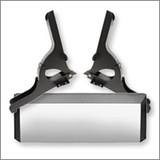
Peterbilt 587 Sleeper & Related
-
 Peterbilt 587 Sleeper Rear Acc.
Peterbilt 587 Sleeper Rear Acc.
-
 Peterbilt 587 Sleeper Repair Parts
Peterbilt 587 Sleeper Repair Parts
-
 Peterbilt 587 Sleeper Roof Acc.
Peterbilt 587 Sleeper Roof Acc.
-
 Peterbilt 587 Sleeper Side Acc.
Peterbilt 587 Sleeper Side Acc.



